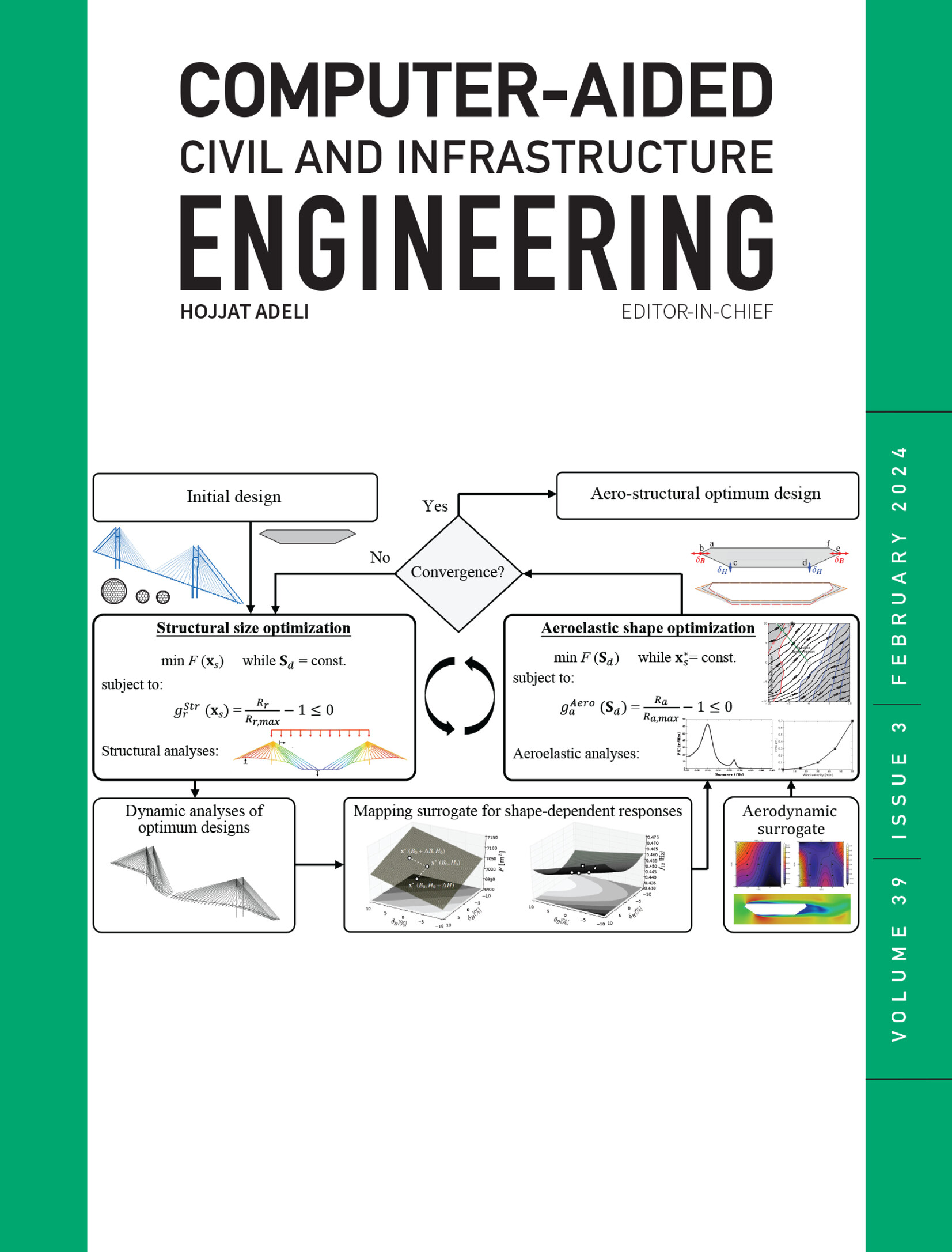Automated defect segmentation and quantification in concrete structures via unmanned aerial vehicle‐based lightweight deep learning
IF 9.1
1区 工程技术
Q1 COMPUTER SCIENCE, INTERDISCIPLINARY APPLICATIONS
引用次数: 0
Abstract
Large‐scale water‐related concrete structures, such as dams, inevitably develop defects over time. Traditional manual inspections are inefficient, hazardous, and prone to high false detection rates. Unmanned aerial vehicles (UAVs) equipped with high‐resolution cameras provide a safer and more efficient alternative. Although deep learning (DL) has advanced defect detection from UAV imagery, many existing approaches are not specifically designed for UAV‐based inspection scenarios, where both inference efficiency and deployment constraints must be carefully considered. In addition, relatively few methods incorporate three‐dimensional (3D) reconstruction for spatial localization and dimensional quantification of concrete defects, limiting the applicability in scenarios requiring precise structural assessment. To overcome current limitations, this study presents an automated framework for defect detection and quantitative assessment in large‐scale concrete structures by integrating UAV photogrammetry, multi‐view 3D reconstruction, and DL techniques. A lightweight defect segmentation method is developed by embedding an enhanced shifted window multi‐head self‐attention module into a streamlined U‐Net architecture, effectively capturing both fine‐grained local details and broader contextual cues. The improved attention mechanism enables efficient inter‐window communication with minimal computational overhead, enhancing the network's ability to detect small and fragmented defects. To further reduce model complexity and improve deployment efficiency, knowledge distillation is applied during training, allowing the student model to maintain high segmentation accuracy with reduced computational cost. In parallel, a multi‐view stereo reconstruction approach is employed to generate accurate 3D point clouds of the inspected structures. Defect locations and dimensions are then quantitatively evaluated through reverse mapping and photogrammetric analysis. The proposed framework is validated through case studies on concrete beams and high‐arch dams. Experimental results demonstrate that the enhanced lightweight U‐Net achieves accurate segmentation, while the 3D reconstruction enables defect‐precise spatial localization and millimeter‐level measurement. These findings highlight the potential of combining UAV imaging, DL, and 3D reconstruction for efficient and reliable inspection of large concrete structures.基于无人机轻量级深度学习的混凝土结构缺陷自动分割与量化
大型与水有关的混凝土结构,如水坝,随着时间的推移,不可避免地会出现缺陷。传统的人工检查效率低、危险,而且容易出现高误检率。配备高分辨率摄像头的无人驾驶飞行器(uav)提供了更安全、更高效的替代方案。尽管深度学习(DL)具有先进的无人机图像缺陷检测技术,但许多现有方法并不是专门为基于无人机的检测场景设计的,在这种情况下,推理效率和部署约束都必须仔细考虑。此外,相对较少的方法将三维(3D)重建用于混凝土缺陷的空间定位和尺寸量化,限制了在需要精确结构评估的场景中的适用性。为了克服目前的限制,本研究提出了一个集成无人机摄影测量、多视角3D重建和深度学习技术的大型混凝土结构缺陷检测和定量评估的自动化框架。通过将增强的移位窗口多头自关注模块嵌入到流线型的U - Net架构中,开发了一种轻量级缺陷分割方法,有效地捕获了细粒度的局部细节和更广泛的上下文线索。改进的注意力机制使窗口间的有效通信以最小的计算开销,增强了网络检测小缺陷和碎片缺陷的能力。为了进一步降低模型复杂性,提高部署效率,在训练过程中应用知识蒸馏,使学生模型在降低计算成本的同时保持较高的分割精度。同时,采用多视角立体重建方法生成被检测结构的精确三维点云。缺陷的位置和尺寸然后通过反向映射和摄影测量分析定量评估。提出的框架通过混凝土梁和高拱坝的案例研究得到了验证。实验结果表明,增强的轻量级U - Net实现了精确的分割,而3D重建实现了缺陷精确的空间定位和毫米级测量。这些发现突出了将无人机成像、DL和3D重建相结合,对大型混凝土结构进行高效可靠检查的潜力。
本文章由计算机程序翻译,如有差异,请以英文原文为准。
求助全文
约1分钟内获得全文
求助全文
来源期刊
CiteScore
17.60
自引率
19.80%
发文量
146
审稿时长
1 months
期刊介绍:
Computer-Aided Civil and Infrastructure Engineering stands as a scholarly, peer-reviewed archival journal, serving as a vital link between advancements in computer technology and civil and infrastructure engineering. The journal serves as a distinctive platform for the publication of original articles, spotlighting novel computational techniques and inventive applications of computers. Specifically, it concentrates on recent progress in computer and information technologies, fostering the development and application of emerging computing paradigms.
Encompassing a broad scope, the journal addresses bridge, construction, environmental, highway, geotechnical, structural, transportation, and water resources engineering. It extends its reach to the management of infrastructure systems, covering domains such as highways, bridges, pavements, airports, and utilities. The journal delves into areas like artificial intelligence, cognitive modeling, concurrent engineering, database management, distributed computing, evolutionary computing, fuzzy logic, genetic algorithms, geometric modeling, internet-based technologies, knowledge discovery and engineering, machine learning, mobile computing, multimedia technologies, networking, neural network computing, optimization and search, parallel processing, robotics, smart structures, software engineering, virtual reality, and visualization techniques.

 求助内容:
求助内容: 应助结果提醒方式:
应助结果提醒方式:


